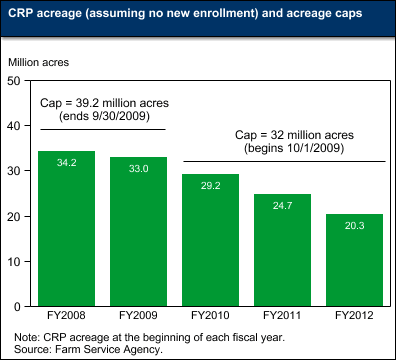|
Land retirement programs play an important role in agricultural
production decisions. In programs administered by USDA's
Farm Service Agency (FSA), producers can receive rental
or other direct payments in return for retiring land
from crop production for 10 or more years.
Program Overviews
The Conservation Reserve Program (CRP) offers annual
payments and cost
sharing to establish long-term, resource-conserving
cover on environmentally sensitive land. The program
offers a periodic "general" signup when landowners can
enroll whole fields and whole farms and an ongoing "continuous" signup
that focuses on high priority, partial field practices
(e.g., field-edge filter strips), wetland restoration,
and State-Federal partnerships to improve the quality
of specific resources such as rivers or lakes (the Conservation
Reserve Enhancement Program, or CREP). Contracts are
for 10-15 years. Both continuous and general signups
are slated to continue under the 2008 Farm Act.
The Wetlands Reserve Program (WRP) provides cost
sharing and long-term or permanent easements for
restoration of wetlands on agricultural land. Easements
prohibit agricultural production but allow landowners
to use the property in ways that do not affect the
health of the wetland ecosystem, such as private or
commercial recreational uses. Ten-year, 30-year, and
permanent easements are available.
Economic Implications
As of May 2008, 34.7 million acres were under CRP contract.
Between May 2008 and the end of 2011, however, contracts
on 13.9 million acres are scheduled to expire. The new
CRP acreage cap leaves room for a steady stream of new
enrollment. Thus, there is ample room for continuing
enrollment of acreage through both the general and continuous
CRP signup. Under CRP continuous signup, land eligible
for high-priority practices (such as field-edge filter
strips and grassed waterways) can be enrolled, as can
land that qualifies for CREP, and the Farmable Wetlands
Program (FWP).

CRP continuous signup will continue. Continuous
enrollment has grown steadily since it began in 1997.
As of May 2008, roughly 4 million acres, or about 12
percent of total enrollment, were under continuous signup
contracts, including CREP and FWP. These contracts also
account for a relatively large share of program payments
to farmers, 23 percent in 2008. Continuous signup contracts
frequently involve high-priority practices that encompass
a small acreage but can produce relatively large environmental
gains. Filter strips, for example, generally encompass
only 1-3 percent of the area drained but can remove 50-90
percent of nitrogen and phosphorous from runoff water.
Land used for riparian buffers, grassed waterways, contour
buffer strips, and wetland restoration practices can
also be enrolled in CRP through continuous signup. While
a continuation of current trends would lead to substantial
increases in continuous CRP enrollment, the 32-million-acre
cap will not be attained without enrollment under general
signups—especially
after 2009, when substantial CRP acreage will expire.

Land retirement to focus on wetlands restoration.
The new WRP acreage cap could allow the enrollment of
more than 1 million additional acres, possibly increasing
program acreage by more than 50 percent. Although WRP
acreage is small relative to CRP acreage, 80 percent
of all WRP contract acreage is in permanent easements,
which (unless a special exemption is granted) do not
allow future agricultural and other nonwetland uses.
While it is initially more expensive to retire land permanently,
the complete restoration of a fully functional wetland
may take many years. Forested wetlands, in particular,
may require decades to reach full function. Wetlands
provide wildlife habitat and improve water quality by
removing nutrients and sediments from water before it
enters rivers and lakes.
Additional wetland acreage can also be enrolled in FWP
and other wetland practices of the CRP. As of May 2008,
2.0 million acres of wetland restoration practices were
under CRP contract.

See Other Title II (Conservation) Program Provisions
See all ERS analysis of program provisions...
|



